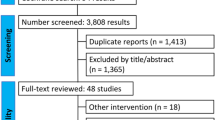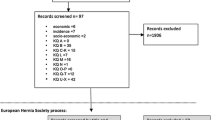Abstract
Purpose
Aim of the study is to compare macroporous (> 1 mm2) polytetrafluoroethylene mesh (LP-PTFE) versus microporous (< 1 mm2) polypropylene mesh (SP-PPL) in terms of postoperative acute and chronic discomfort and pain, difficulty in mesh handling and long-term recurrence rate.
Methods
Fifty-two patients with bilateral hernia were enrolled in this double-blind randomized controlled trial (NCT02023203). Each hernia, in the same patient, was randomized to implant LP-PTFE or SP-PPL mesh during totally extraperitoneal laparoscopic hernia repair. Patients were followed at 7 days, 1, 3, 6, 12 and 60 months after surgery. Visual analog scale (VAS) score was employed to evaluate the outcomes. Student’s t test was used in case of normally distributed continuous variables, while the nonparametric Mann–Whitney U test was used in case of not normally distributed variables. Chi square test was used for analysis of categorical variables.
Results
Median VAS discomfort score with SP-PPL was significantly higher than LP-PTFE at 1 and 3 months after surgery (p = 0.003 in both cases). LP-PTFE showed significantly lower median score than SP-PPL at 7 days after surgery (p = 0.025) regarding pain at movement. Testicular pain was lower in case of LP-PTFE than SP-PPL at 7 days, 1 and 3 months after surgery (p = 0.005, p = 0.004 and p = 0.004, respectively). LP-PTFE was significantly more difficult to handle (p = 0.001). At 60 months, one recurrence was observed in the LP-PTFE group (p = 1.0000).
Conclusions
LP-PTFE has less postoperative discomfort and pain up to 3 months after surgery, without differences after that period, although it shows more difficulty in handling and recurrences occur even if not statistically significant.






Similar content being viewed by others
References
Jenkins JT, O’Dwyer PJ (2008) Inguinal hernias. BMJ 336(7638):269–272. https://doi.org/10.1136/bmj.39450.428275.ad
Lau WY (2002) History of treatment of groin hernia. World J Surg 26(6):748–759
Zimmerman LM, Heller RE (1937) Edoardo Bassini: his role in the development of hernial surgery. Surg Gynecol Obstet 64:971–973
Lichtenstein IL, Shulman AG, Amid PK, Montllor MM (1989) The tension-free hernioplasty. Am J Surg 157(2):188–193
Scott NW, McCormack K, Graham P, Go PM, Ross SJ, Grant AM (2002) Open mesh versus non-mesh for repair of femoral and inguinal hernia. Cochrane Database Syst Rev. https://doi.org/10.1002/14651858.cd002197
Memon MA, Cooper NJ, Memon B, Memon MI, Abrams KR (2003) Meta-analysis of randomized clinical trials comparing open and laparoscopic inguinal hernia repair. Br J Surg 90(12):1479–1492
Coda A, Lamberti R, Martorana S (2012) Classification of prosthetics used in hernia repair based on weight and biomaterial. Hernia 16(1):9–20. https://doi.org/10.1007/s10029-011-0868-z
Klinge U, Junge K, Stumpf M, Öttinger AP, Klosterhalfen B (2002) Functional and morphological evaluation of a low-weight, monofilament polypropylene mesh for hernia repair. J Biomed Mater Res 63(2):129–136
Currie A, Andrew H, Tonsi A, Hurley PR, Taribagil S (2012) Lightweight versus heavyweight mesh in laparoscopic inguinal hernia repair: a meta-analysis. Surg Endosc 26(8):2126–2133. https://doi.org/10.1007/s00464-012-2179-6
Miserez M, Alexandre JH, Campanelli G, Corcione F, Cuccurullo D, Pascual MH, Hoeferlin A, Kingsnorth AN, Mandala V, Palot JP, Schumpelick V, Simmermacher RK, Stoppa R, Flament JB (2007) The European hernia society groin hernia classification: simple and easy to remember. Hernia 11(2):113–116
Cunningham J, Temple WJ, Mitchell P, Nixon JA, Preshaw RM, Hagen NA (1996) Cooperative hernia study Pain in the postrepair patient. Ann Surg 224(5):598–602
HerniaSurge Group (2018) International guidelines for groin hernia management. Hernia 22(1):1–165. https://doi.org/10.1007/s10029-017-1668-x
Bay-Nielsen M, Perkins FM, Kehlet H, Danish Hernia Database (2001) Pain and functional impairment 1 year after inguinal herniorrhaphy: a nationwide questionnaire study. Ann Surg. 233(1):1–7
Arregui ME, Davis CJ, Yucel O, Nagan RF (1992) Laparoscopic mesh repair of inguinal hernia using a preperitoneal approach: a preliminary report. Surg Laparosc Endosc 2(1):53–58
Dulucq JL (1992) Treatment of inguinal hernia by insertion of a subperitoneal patch under pre-peritoneoscopy. Chirurgie 118(1–2):83–85
Earle DB, Mark LA (2008) Prosthetic material in inguinal hernia repair: how do I choose. Surg Clin North Am 88(1):179–201. https://doi.org/10.1016/j.suc.2007.11.002
Wake BL, McCormack K, Fraser C, Vale L, Perez J, Grant AM (2005) Transabdominal pre-peritoneal (TAPP) vs totally extraperitoneal (TEP) laparoscopic techniques for inguinal hernia repair. Cochrane Database Syst Rev. https://doi.org/10.1002/14651858.CD004703.pub2
Liew W, Wai YY, Kosai NR, Gendeh HS (2017) Tackers versus glue mesh fixation: an objective assessment of postoperative acute and chronic pain using inflammatory markers. Hernia. 21(4):549–554. https://doi.org/10.1007/s10029-017-1611-1
Berney CR, Descallar J (2016) Review of 1000 fibrin glue mesh fixation during endoscopic totally extraperitoneal (TEP) inguinal hernia repair. Surg Endosc 30(10):4544–4552. https://doi.org/10.1007/s00464-016-4791-3
Golani S, Middleton P (2017) Long-term follow-up of laparoscopic total extraperitoneal (TEP) repair in inguinal hernia without mesh fixation. Hernia 21(1):37–43. https://doi.org/10.1007/s10029-016-1558-7
Klosterhalfen B, Klinge U, Rosch R, Junge K. (2003). Long-term inertness of meshes. In: Meshes: Benefits and Risks. Schumpelick V, Nyhus L, eds. Springer-Verlag
Novitsky YW, Cristiano JA, Harrell AG, Newcomb W, Norton JH, Kercher KW, Heniford BT (2008) Immunohistochemical analysis of host reaction to heavyweight-, reduced-weight-, and expanded polytetrafluoroethylene (ePTFE)-based meshes after short- and long-term intraabdominal implantations. Surg Endosc 22(4):1070–1076. https://doi.org/10.1007/s00464-007-9737-3
Jacob DA, Schug-Pass C, Sommerer F, Tannapfel A, Lippert H, Köckerling F (2012) Comparison of a lightweight polypropylene mesh (Optilene® LP) and a large-pore knitted PTFE mesh (GORE® INFINIT® mesh)–Biocompatibility in a standardized endoscopic extraperitoneal hernia model. Langenbecks Arch Surg 397(2):283–289. https://doi.org/10.1007/s00423-011-0858-8
Melman L, Jenkins ED, Hamilton NA, Bender LC, Brodt MD, Deeken CR, Greco SC, Frisella MM, Matthews BD (2011) Histologic and biomechanical evaluation of a novel macroporous polytetrafluoroethylene knit mesh compared to lightweight and heavyweight polypropylene mesh in a porcine model of ventral incisional hernia repair. Hernia 15(4):423–431. https://doi.org/10.1007/s10029-011-0787-z
Khan LR, Liong S, de Beaux AC, Kumar S, Nixon SJ (2010) Lightweight mesh improves functional outcome in laparoscopic totally extra-peritoneal inguinal hernia repair. Hernia 14(1):39–45. https://doi.org/10.1007/s10029-009-0558-2
Khan LR, Kumar S, Nixon SJ (2006) Early results for new lightweight mesh in laparoscopic totally extra-peritoneal inguinal hernia repair. Hernia 10(4):303–308
Chowbey PK, Garg N, Sharma A, Khullar R, Soni V, Baijal M, Mittal T (2010) Prospective randomized clinical trial comparing lightweight mesh and heavyweight polypropylene mesh in endoscopic totally extraperitoneal groin hernia repair. Surg Endosc 24(12):3073–3079. https://doi.org/10.1007/s00464-010-1092-0
Chui LB, Ng WT, Sze YS, Yuen KS, Wong YT, Kong CK (2010) Prospective, randomized, controlled trial comparing lightweight versus heavyweight mesh in chronic pain incidence after TEP repair of bilateral inguinal hernia. Surg Endosc 24(11):2735–2738. https://doi.org/10.1007/s00464-010-1036-8
Agarwal BB, Agarwal KA, Mahajan KC (2009) Prospective double-blind randomized controlled study comparing heavy- and lightweight polypropylene mesh in totally extraperitoneal repair of inguinal hernia: early results. Surg Endosc 23(2):242–247. https://doi.org/10.1007/s00464-008-0188-2
Scheidbach H, Tamme C, Tannapfel A, Lippert H, Köckerling F (2004) In vivo studies comparing the biocompatibility of various polypropylene meshes and their handling properties during endoscopic total extraperitoneal (TEP) patchplasty: an experimental study in pigs. Surg Endosc 18(2):211–220
Acknowledgments
The authors are grateful to Juan Manuel Praena for his advice on the statistical analysis and Dr. Jean Carrasquillo for the translation support.
Funding
There are no grant support or financial relationship for the present study.
Author information
Authors and Affiliations
Corresponding author
Ethics declarations
Conflicts of interest
Dr. Isaias Alarcón, Dr. Andrea Balla, Dr. Joan Ricard Soler Frias, Dr. Antonio Barranco, Dr. Juan Bellido Luque and Prof. Salvador Morales-Conde have no conflicts of interest or financial ties to disclose.
Ethical approval
This study complied the current law of Spain.
Human and animal rights
All procedures performed in this study involving human participants were in accordance with the ethical standards of our institutional and national research committee and with the 1964 Helsinki declaration and its later amendments or comparable ethical standards.
Informed consent
Informed consent was obtained from all individual participants included in the study.
Additional information
Publisher's Note
Springer Nature remains neutral with regard to jurisdictional claims in published maps and institutional affiliations.
Rights and permissions
About this article
Cite this article
Alarcón, I., Balla, A., Soler Frías, J.R. et al. Polytetrafluoroethylene versus polypropylene mesh during laparoscopic totally extraperitoneal (TEP) repair of inguinal hernia: short- and long-term results of a double-blind clinical randomized controlled trial. Hernia 24, 1011–1018 (2020). https://doi.org/10.1007/s10029-020-02200-y
Received:
Accepted:
Published:
Issue Date:
DOI: https://doi.org/10.1007/s10029-020-02200-y




